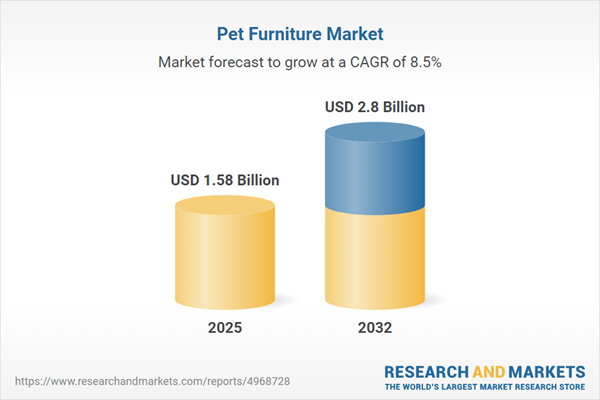Speak directly to the analyst to clarify any post sales queries you may have.
The global pet furniture market is evolving rapidly, driving senior leaders to prioritize sustainability practices and innovation in product development. As client demands shift and regulatory landscapes fluctuate, real-time market intelligence becomes an essential strategic resource.
Market Snapshot: Growth Dynamics in the Pet Furniture Market
The pet furniture market demonstrates consistent expansion, supported by rising demand in both residential and commercial applications. Growth is further influenced by the evolution of product designs that prioritize adaptability and multi-functionality. Companies enhance their product portfolios with modular ranges and specialty items designed to address a variety of client requirements. Digital transformation, through the adoption of online retail and omnichannel approaches, is reshaping the way buyers engage, compelling competitors to remain agile and responsive. Ongoing trends emphasize sustainable procurement, with brands aligning offerings to the increasing demand for environmentally responsible and personalized solutions.
Scope & Segmentation: Pet Furniture Market Insights
A comprehensive view of the pet furniture market uncovers diverse opportunities across client types and regional territories. Effective market strategies are anchored in understanding product innovation, channel development, and technological integration tailored to distinct segments. Each strategic area presents its own challenges and prospects for sustained growth and secure market positioning.
- Product Types: Cat trees, towers, pet sofas, beds, crates, kennels, cages, enclosures, houses, and scratching posts, all engineered to fulfill comfort needs and maximize space utility for homes and businesses.
- Material Types: Fabric, upholstery, metal, plastic, and wood materials contribute to product durability and support compliance with modern sustainability standards.
- Distribution Channels: Furniture outlets, pet specialty stores, supermarkets, hypermarkets, veterinary clinics, and digital marketplaces ensure broad market access and diverse customer touchpoints.
- End Use: Product solutions target operational and aesthetic requirements across boarding centers, grooming facilities, shelters, and domestic settings, enabling organizations to serve an extensive client spectrum.
- Geographic Regions: Americas, Europe, Middle East, Africa, and Asia-Pacific reveal variations in consumer behavior and supply chain structure, reinforcing the need for localized engagement strategies.
- Technological Applications: Modular manufacturing, improved production efficiencies, and adoption of digital procurement systems streamline operations, providing scalable partnership options for vendors and service providers.
Key Takeaways for Senior Decision-Makers
- Expanding product portfolios with adaptable and innovative designs enhances positioning in both residential and commercial target segments.
- Championing transparent and environmentally responsible supply chain practices supports trust-building and resilient business relationships.
- Pursuing strategic alliances in pet care and furniture design enables timely responses to emerging client needs and evolving industry standards.
- Integrating modular features with digital engagement platforms increases customization potential and deepens relationships within distribution channels.
- Committing to regionalized operating strategies helps balance the deployment of advanced technologies with effective local adaptation, improving agility and presence.
- Maintaining ethical and disciplined corporate practices strengthens brand integrity during cross-border operations and collaborative ventures.
Tariff Impact: Navigating Shifts in Trade Policy
Recent U.S. tariff adjustments are directly affecting pet furniture products that utilize engineered wood and specialty textiles. Manufacturers are adapting by moving specific production processes to regions such as Latin America and the Caribbean. Investments in automation and diversification of supplier networks are also supporting consistent supply and operational stability amid a changing trade environment.
Methodology & Data Sources
This research leverages secondary market data, direct consultation with industry stakeholders, iterative validation, exploratory pilot studies, and proprietary shipment analysis. These combined methods enable a robust understanding of prevailing trends and inform the report’s actionable recommendations.
Why This Report Matters
- Empowers senior leadership to optimize resource allocation in line with long-term, sustainable expansion.
- Delivers up-to-date analysis on regulatory and supply chain developments to help anticipate market risks and accelerate business adjustments.
- Offers reliable benchmarks by product and region, assisting data-driven evaluation and scalable partnership opportunities.
Conclusion
By investing in adaptive strategies and advancing transparent supply chains, organizations position themselves to navigate current and future market challenges successfully. These approaches foster sustained resilience and growth across evolving global markets.
Additional Product Information:
- Purchase of this report includes 1 year online access with quarterly updates.
- This report can be updated on request. Please contact our Customer Experience team using the Ask a Question widget on our website.
Table of Contents
3. Executive Summary
4. Market Overview
7. Cumulative Impact of Artificial Intelligence 2025
Companies Mentioned
The companies profiled in this Pet Furniture market report include:- Chewy, Inc.
- Central Garden & Pet Company
- MidWest Homes for Pets, Inc.
- Petmate, Inc.
- K&H Manufacturing Company, Inc.
- Aspen Pet Products, Inc.
- PetFusion LLC
- Armarkat Pet Products, LLC
- Trixie Heimtierbedarf GmbH & Co. KG
- FurryLiving
Table Information
| Report Attribute | Details |
|---|---|
| No. of Pages | 198 |
| Published | November 2025 |
| Forecast Period | 2025 - 2032 |
| Estimated Market Value ( USD | $ 1.58 Billion |
| Forecasted Market Value ( USD | $ 2.8 Billion |
| Compound Annual Growth Rate | 8.5% |
| Regions Covered | Global |
| No. of Companies Mentioned | 11 |









